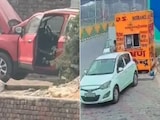The government has enforced stricter anti-pollution measures in Delhi and the NCR as air quality plunged to "severe" levels this week. The Commission for Air Quality Management invoked Stage 3 of the Graded Response Action Plan (GRAP) on Tuesday, banning non-essential construction and restricting industrial activities using polluting fuels.
The Air Quality Index (AQI) at several stations in Delhi crossed 400, far above the "good" threshold of 50, as per Central Pollution Control Board data. The worsening air quality also triggered public outrage, with a rare protest at India Gate over the weekend where dozens demanding cleaner air were detained.
Satellite data indicates a sharp rise in stubble burning across northern India-one of the recurring factors behind Delhi's toxic winter smog. Authorities say the current steps aim to curb further deterioration, but pollution remains a persistent challenge for the capital and its surrounding regions during this season.
Key Pollution Sources: The problem stems from a mix of persistent local emissions and seasonal events.
Primary Year-Round Local Sources
Vehicular Emissions: Consistently a leading source of pollution in Delhi, contributing significantly to levels of PM2.5, PM10, and nitrogen oxides (NOx). The high density of private vehicles and heavy commercial traffic are major factors.
Dust: Road dust and fine particles generated from extensive construction and demolition activities are substantial contributors to airborne particulate matter.
Industrial Pollution: Industries, including brick kilns and thermal power plants within and surrounding the NCR, continue to emit significant pollutants like sulfur dioxide (SO2) and particulate matter.
Biomass and Waste Burning: Open burning of solid waste, garbage, and biomass (wood, cow dung) for domestic heating or disposal adds considerably to the pollution load, particularly during cooler months.
Major Seasonal Regional Sources
Agricultural Crop Burning: During the post-monsoon period (October-November), the practice of burning agricultural residue (stubble) in neighboring states like Punjab and Haryana is a primary episodic source, with north-westerly winds carrying dense smoke into Delhi NCR. This can account for up to 45% of Delhi's pollution on peak days.
Adverse Weather Conditions: Delhi's landlocked geography and winter meteorology, including low wind speeds and temperature inversions, trap pollutants near the surface, leading to severe smog episodes.
Bottom Line
Air pollution in Delhi-NCR in 2025 is driven by a combination of heavy vehicle traffic, construction and dust, domestic biomass use, industrial emissions, seasonal crop-burning and unfavourable weather trapping pollutants. The result: years of healthy life lost and a health crisis in waiting.
(With inputs from agencies)















